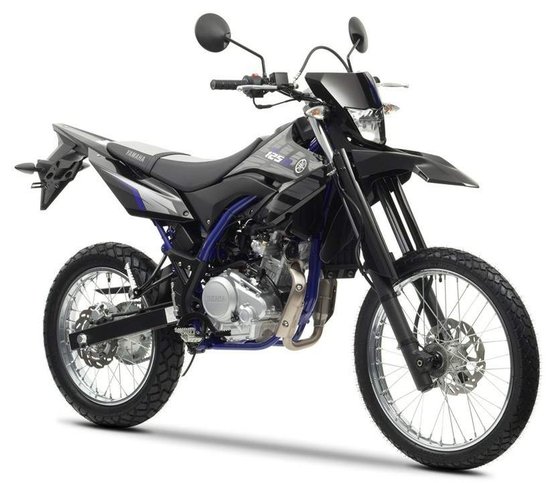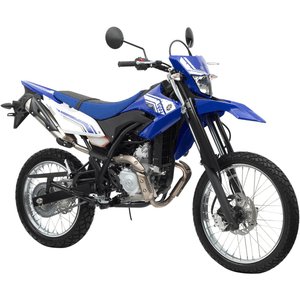Yamaha WR 125 R (2015–2017): A Versatile 125cc Enduro for the Adventurous Soul

Introduction
The Yamaha WR 125 R, produced between 2015 and 2017, is a motorcycle that defies the limitations of its 125cc class. Designed as a full-sized enduro, it bridges the gap between entry-level trail bikes and serious off-road machines. Whether you’re navigating rocky paths, commuting through city streets, or exploring fire roads, the WR 125 R offers a surprisingly capable platform.
What sets this bike apart is its liquid-cooled, fuel-injected engine—a rarity in the 125cc segment during its time—and its aggressive, purpose-built design. Let’s dive into what makes this motorcycle a standout choice for riders seeking versatility and reliability.
Design: Built to Conquer, Engineered to Last
Aggressive Aesthetics
The WR 125 R sports Yamaha’s signature off-road styling: a sharp, angular bodywork with minimalistic panels, a high-mounted front fender, and a slim profile. Available in Sports White and Yamaha Black, its color schemes emphasize functionality over flashiness. The steel double-cradle frame isn’t just durable; it’s lightweight, contributing to the bike’s 133 kg (293 lbs) wet weight.
Ergonomics for Adventure
With a 930 mm (36.6-inch) seat height, this bike is tailored for riders who aren’t intimidated by a lofty perch. The standing-friendly ergonomics—wide handlebars, neutral footpeg placement, and a narrow seat—make it easy to shift weight during off-road maneuvers. However, shorter riders might find the seat height challenging at stops.
Suspension and Wheels
- Front Suspension: 41 mm telescopic forks with 210 mm (8.3 inches) of travel.
- Rear Suspension: Link-type monoshock offering 230 mm (9.1 inches) of travel.
- Wheels: A 21-inch front and 18-inch rear combo wrapped in dual-purpose tires strike a balance between off-road grip and on-road stability.
The 265 mm (10.4-inch) ground clearance ensures you’ll glide over logs and rocks without scraping the underbelly.
Engine and Performance: Small Displacement, Big Attitude
The Heart of the Machine
The WR 125 R’s 124.7 cc liquid-cooled, SOHC 4-valve single-cylinder engine is a gem. Fuel injection delivers crisp throttle response, eliminating the cold-start woes of carbureted rivals. It produces 15 HP (11 kW) at 9,000 RPM and 12.2 Nm (9 ft-lbs) of torque, peaking at 6,000 RPM.
On the Road and Trail
- Low-End Grunt: The torque curve is biased toward the mid-range, making it responsive in technical terrain.
- Gearing: Most models feature a 5-speed transmission, though some later iterations may include a 6-speed. The 14/53 sprocket combo prioritizes low-speed control over top speed.
- Fuel Efficiency: With an 8.5-liter (2.2-gallon) tank, expect 200–250 km (124–155 miles) per fill-up, depending on riding style.
While it won’t win highway races (top speed hovers around 100 km/h / 62 mph), the engine thrives in off-road environments where precision matters more than power.
Handling: Light, Nimble, and Predictable
Off-Road Dominance
The WR 125 R’s lightweight chassis and long-travel suspension make it a joy on rough terrain. The 21-inch front wheel rolls over obstacles effortlessly, while the rear 18-inch wheel provides stability on loose surfaces. Steering is quick thanks to a 27-degree rake and 107 mm (4.2-inch) trail, though it remains stable at higher speeds.
On-Road Manners
The dual-purpose tires and upright riding position are comfortable for short commutes, but the tall seat and firm suspension remind you this bike belongs in the dirt. The 248 mm front and 220 mm rear hydraulic discs offer ample stopping power, with a progressive feel that inspires confidence.
Competition: How Does the WR 125 R Stack Up?
KTM 125 EXC
- Pros: More power (18 HP), lighter weight.
- Cons: Carbureted engine, higher maintenance costs.
- Verdict: The KTM is a racier option, but the Yamaha’s fuel injection and reliability edge make it better for daily riders.
Honda CRF125L
- Pros: Lower seat height (844 mm / 33.2 inches), air-cooled simplicity.
- Cons: Outdated carbureted engine, less suspension travel.
- Verdict: The Honda is friendlier to beginners, but the WR 125 R outperforms it off-road.
Beta RR 125
- Pros: Premium components (e.g., Sachs suspension), 6-speed gearbox.
- Cons: Higher price, niche dealer network.
- Verdict: The Beta excels in competition settings, but the Yamaha strikes a better balance for mixed use.
Maintenance: Keeping Your WR 125 R in Peak Condition
Key Service Intervals
- Oil Changes: Use 1.0L of SAE 10W-40 (API SG) every 3,000–5,000 km (1,864–3,107 miles). Consider MOTOPARTS.store’s synthetic blends for extended intervals.
- Valve Adjustments: Check every 10,000 km (6,214 miles). Intake: 0.10–0.14 mm (0.004–0.006 in), exhaust: 0.20–0.24 mm (0.008–0.009 in).
- Chain Care: The 132-link chain requires regular cleaning and lubrication. Upgrade to an O-ring chain for durability.
Recommended Upgrades
- Spark Plugs: NGK CR8E or iridium CR8EIX for improved longevity.
- Brake Fluid: DOT 4 fluid ensures consistent performance in all conditions.
- Tires: Swap to aggressive knobbies (e.g., Pirelli MT21) for serious off-roading.
Conclusion: A 125cc Champion for the Real World
The Yamaha WR 125 R isn’t just a beginner bike—it’s a capable all-rounder that rewards skill and adapts to diverse terrain. Its fuel-injected engine, robust chassis, and off-road DNA make it a standout in the 125cc class. While taller riders will appreciate its ergonomics, the seat height might deter some.
For those seeking a low-maintenance, go-anywhere machine that’s equally at home on trails and backroads, the WR 125 R remains a compelling choice. And when it’s time to service or upgrade, MOTOPARTS.store has the parts to keep your adventure alive.
Specifications sheet
| Engine | |
|---|---|
| Stroke: | Four-stroke |
| Ignition: | TCI |
| Max power: | 11 kW | 15.0 hp |
| Max torque: | 12.2 Nm |
| Fuel system: | Fuel Injection |
| Lubrication: | Wet sump |
| Max power @: | 9000 rpm |
| Displacement: | 125 ccm |
| Max torque @: | 6000 rpm |
| Bore x Stroke: | 52.0 x 58.6 mm (2.0 x 2.3 in) |
| Configuration: | Single |
| Cooling system: | Liquid cooled |
| Compression ratio: | 11.2:1 |
| Number of cylinders: | 1 |
| Dimensions | |
|---|---|
| Wheelbase: | 1430 mm (56.3 in) |
| Dry weight: | 133 |
| Seat height: | 930 mm (36.6 in) |
| Ground clearance: | 265 mm (10.4 in) |
| Fuel tank capacity: | 8.5 L (2.2 US gal) |
| Drivetrain | |
|---|---|
| Final drive: | chain |
| Gear ratios: | ['1st: 2.333', '2nd: 3.067', '3rd: 2.063', '4th: 1.579', '5th: 1.259'] |
| Chain length: | 132 |
| Transmission: | 5-speed |
| Rear sprocket: | 53 |
| Front sprocket: | 14 |
| Maintainance | |
|---|---|
| Rear tire: | 110/80-18 |
| Engine oil: | 10W40 |
| Front tire: | 80/90-21 |
| Break fluid: | DOT 4 |
| Spark plugs: | NGK CR8E or NGK CR8EIX |
| Spark plug gap: | 0.7 |
| Coolant capacity: | 1.1 |
| Forks oil capacity: | 1.12 |
| Engine oil capacity: | 1.0 |
| Engine oil change interval: | Every 5000 km or 2 years |
| Valve clearance (intake, cold): | 0.10–0.14 mm |
| Valve clearance check interval: | 24,000 km / 15,000 mi |
| Valve clearance (exhaust, cold): | 0.20–0.24 mm |
| Recommended tire pressure (rear): | 2.0 bar (29 psi) solo, 2.25 bar (33 psi) with passenger |
| Recommended tire pressure (front): | 2.0 bar (29 psi) |
| Wheels and Tires | |
|---|---|
| Rake: | 27° |
| Trail: | 107 mm (4.2 in) |
| Rear wheel size: | 18-inch |
| Front wheel size: | 21-inch |
| Chassis and Suspension | |
|---|---|
| Frame: | Steel double cradle |
| Rear brakes: | Single 220 mm disc |
| Front brakes: | Single 248 mm disc |
| Rear suspension: | Swingarm with link-type monoshock |
| Front suspension: | 41 mm telescopic fork |
| Rear wheel travel: | 230 mm (9.1 in) |
| Front wheel travel: | 210 mm (8.3 in) |



















